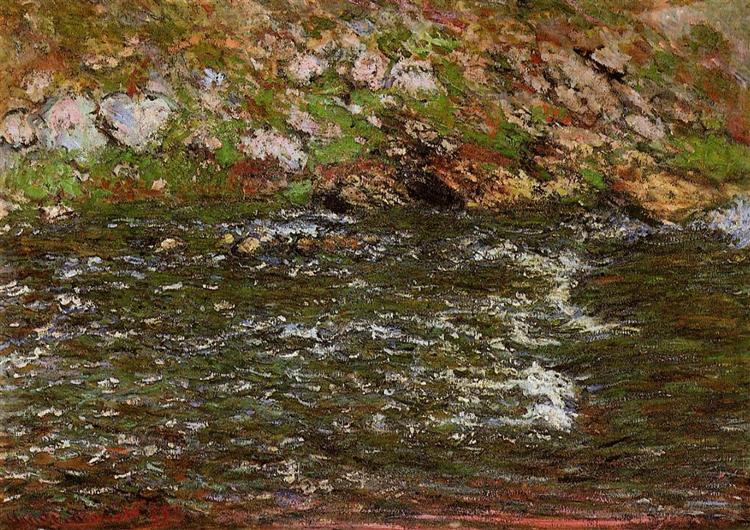Opis
Obraz „Torrent de la Petite Creuse we Fresselines” Claude Moneta, wykonany w 1889 r., Jest manifestacją głębokiego ogniwa, który artysta wykuł z przyrodą i znakomity okaz jego przejścia do eksploracji światła i atmosfery w krajobrazie w krajobrazie . W tej pracy Monet oddaje określony moment w trakcie Petite Creuse River, która działa z witalnością, która wydaje się rezonować z energią samej natury. Obraz ten znajduje się w okresie, w którym Monet intensywnie doświadczył ze sposobem reprezentowania światła i koloru, co zakończyłaby się słynną serią potrzebujących.
Skład pracy jest dynamiczny, naznaczony falą wody i nieregularnym konstrukcją skał wynikających z potoku. Monet udaje się przekazać poczucie ruchu przez luźne i płynne pociągnięcia pędzla, które charakteryzują jego impresjonistyczny styl. Podejście to podkreśla bezpośredniość reprezentowanej chwili, co sugeruje, że obserwator jest świadkiem ciągłej zmiany. Solidne skały i porywczych prądów rzeki są kontrastowane z otaczającą roślinnością, tworząc harmonijną, ale napiętą interakcję między wiecznym i efemerycznym.
Zastosowanie koloru jest szczególnie godne uwagi w tej pracy. Monet wykazuje żywą paletę, która obejmuje niuanse niebieskiego i zielonego, które dają ożywienie wody i otaczającemu krajobrazie. Fale wodne odzwierciedlają światło prawie namacalne, podczas gdy cienie są przeplatane w subtelnym dialogu z lżejszymi tonami, sugerując głębokości i tekstury, które zapraszają widza do eksploracji poza powierzchnią. Ta różnorodność kolorów jest nie tylko windykacją krajobrazu, ale także święto impresjonistycznej estetyki, która ma na celu uchwycenie wrażeń wizualnych, a nie precyzyjnych szczegółów.
Chociaż obraz nie przedstawia wyraźnie ludzkich postaci, jego obecność jest postrzegana przez samą naturę. Monet często starał się obejmować ludzi w swoich krajobrazach, ale w „Torrent de la Petite Creuse we Fresselines” rzeka staje się prawdziwym bohaterem. To pokazuje zdolność Moneta do zachęcania krajobrazu, nawet przy braku ludzkich form, wchłaniając naturę własnej osobowości. Dlatego praca może być postrzegana jako odzwierciedlenie jego podziwu dla efektów, jakie światło i atmosfera mają na środowisko naturalne.
Ta praca jest częścią kluczowego okresu w życiu Monet, podczas jego pobytu we Fresselines, gdzie znalazł inspirację w otaczających go krajobrazach. Drobne Creuse, ze stromym profilem i szybkimi wodami, oferowało tło, które stymulowało jego kreatywność. To spotkanie z naturą w najdzikszej i pięknej formie jest przewodnikiem w trajektorii artysty, pozwalając mu eksperymentować i kwestionować konwencje klasycznego obrazu jego czasów.
Podsumowując, „Torrent de la Petite Creuse in Fresselines” jest nie tylko świadectwem talentu Moneta jako malarza, ale także jego innowacyjnego nacisku na krajobraz. Poprzez żywy kompozycję i traktowanie koloru i światła, Monet przywołuje esencję naturalnego doświadczenia, zachęcając swoich widzów do kontemplowania ulotnego piękna otaczającego go świata. Dzieło, które w swojej prostocie ujawnia złożoność związku między sztuką a naturą, i nadal rezonuje we współczesnej wrażliwości na środowisko.
KUADROS ©, słynna farba na ścianie.
Ręcznie wykonane obrazy olejne, z jakością profesjonalnych artystów i charakterystyczną pieczęcią KUADROS ©.
Usługa reprodukcji zdjęć z gwarancją satysfakcji. Jeśli nie jesteś w pełni zadowolony z repliki twojego obrazu, zwrócimy twoje pieniądze w 100%.

